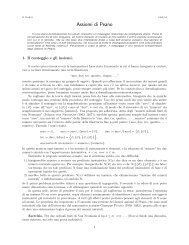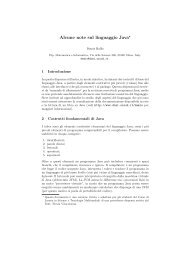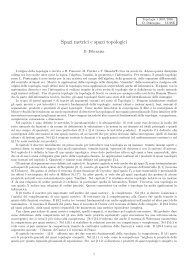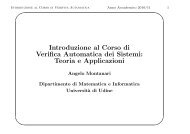Il teorema di Weierstrass
Il teorema di Weierstrass
Il teorema di Weierstrass
You also want an ePaper? Increase the reach of your titles
YUMPU automatically turns print PDFs into web optimized ePapers that Google loves.
212 CAPITOLO 21. IL TEOREMA DI WEIERSTRASS<br />
[a2, b2]. Sia xn2 un qualunque elemento della successione (xn) (n > n1)<br />
che appartiene a [a2, b2]. Continuando in questa maniera costruiamo tre<br />
successioni ak, bk e xnk tali che<br />
1. ak è crescente e bk è decrescente;<br />
2. bk − ak =<br />
b − a<br />
2 k<br />
per ogni k ∈ N;<br />
3. (xnk ) k∈N è una sottosuccessione <strong>di</strong> (xn);<br />
4. ak ≤ xnk ≤ bk per ogni k ∈ N.<br />
Poiché (ak) è monotona e limitata (superiormente da b e inferiormente da a)<br />
allora esiste il limk→+∞ ak = ¯x e per la 2. anche limk→+∞ bk = ¯x cosicché<br />
per la 4. e il <strong>teorema</strong> del confronto si ha limk→+∞ xnk = ¯x. ✷<br />
Corollario 21.2 Ogni successione <strong>di</strong> numeri reali possiede una sottosuccessione<br />
che ammette limite.<br />
Dimostrazione Se la successione (xn) è limitata, allora per il <strong>teorema</strong><br />
precedente ammette una sottosuccessione convergente.<br />
Se, invece, la successione (xn) non è limitata, allora non lo è inferiormente<br />
oppure superiormente. Supponiamo che (xn) non sia limitata superiormente<br />
(il caso in cui (xn) non è limitata inferiormente si tratta in modo analogo).<br />
Dimostriamo allora che (xn) possiede una sottosuccessione <strong>di</strong>vergente a +∞.<br />
Infatti, poiché la successione non è limitata superiormente, per ogni k ∈ N<br />
esiste nk tale che xnk > k.<br />
Osserviamo che (xnk ) non è necessariamente una sottosuccessione <strong>di</strong> (xn)<br />
perché l’applicazione k → nk non è detto che sia strettamente crescente. Per<br />
ottenere una sottosuccessione basta mo<strong>di</strong>ficare leggermente il proce<strong>di</strong>mento<br />
precedente. Infatti, dato k = 1 esiste xn1 tale che f(xn1 ) > 1. Procedendo<br />
per induzione, una volta definito xnk , sia nk+1 > nk tale che f(xnk+1 ) > k+1.<br />
In questo modo si definisce una sottosuccessione <strong>di</strong> (xn) tale che f(xnk ) > k<br />
per ogni k ∈ N. Per il <strong>teorema</strong> del confronto<br />
lim f(xnk ) = +∞.<br />
k→+∞<br />
Teorema 21.3 (<strong>di</strong> <strong>Weierstrass</strong>) Sia f una funzione continua in un intervallo<br />
chiuso e limitato [a, b]. Allora f assume massimo e minimo in [a, b],<br />
cioè esistono<br />
min f e max<br />
[a,b] [a,b] f.





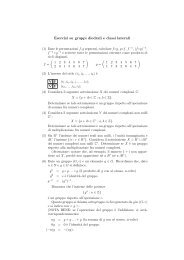
![(Microsoft PowerPoint - slide1Intro.ppt [modalit\340 compatibilit\340])](https://img.yumpu.com/15950642/1/184x260/microsoft-powerpoint-slide1introppt-modalit340-compatibilit340.jpg?quality=85)
